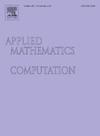Modeling and experimental circuit implementation of fractional single-transistor chaotic oscillators
IF 3.5
2区 数学
Q1 MATHEMATICS, APPLIED
引用次数: 0
Abstract
This study presents the first experimental realization of a single-transistor fractional chaotic oscillator, obtained by extending a minimalistic integer-order circuit by systematically transforming its reactive components, namely two inductors and a capacitor, into fractional elements. Starting from the Grünwald-Letnikov definition and using a string structure finite-order approximation for implementation, the dynamics are studied over a range of fractional orders. Results from equation models, circuit simulations, and experimental measurements are juxtaposed, yielding broadly consistent results. The introduction of fractional elements is found to have profound effects on the chaotic dynamics, influencing oscillation amplitude, spectral flatness, and bifurcation characteristics. In particular, inspection of the resulting Poincaré sections reveals a gradual distortion of the interplay between the relaxation and resonance aspects of the circuit dynamics with decreasing fractional order. While less generative than other manipulations, such as inserting fractal resonators, the ability to introduce fractional components into elementary nonlinear oscillator circuits provides a new, highly versatile, and compact physical tool. Potential applications include modeling electronically real-world phenomena endowed with considerable memory and nonlocality, such as neural activity and viscoelasticity.
求助全文
约1分钟内获得全文
求助全文
来源期刊
CiteScore
7.90
自引率
10.00%
发文量
755
审稿时长
36 days
期刊介绍:
Applied Mathematics and Computation addresses work at the interface between applied mathematics, numerical computation, and applications of systems – oriented ideas to the physical, biological, social, and behavioral sciences, and emphasizes papers of a computational nature focusing on new algorithms, their analysis and numerical results.
In addition to presenting research papers, Applied Mathematics and Computation publishes review articles and single–topics issues.

 求助内容:
求助内容: 应助结果提醒方式:
应助结果提醒方式:


